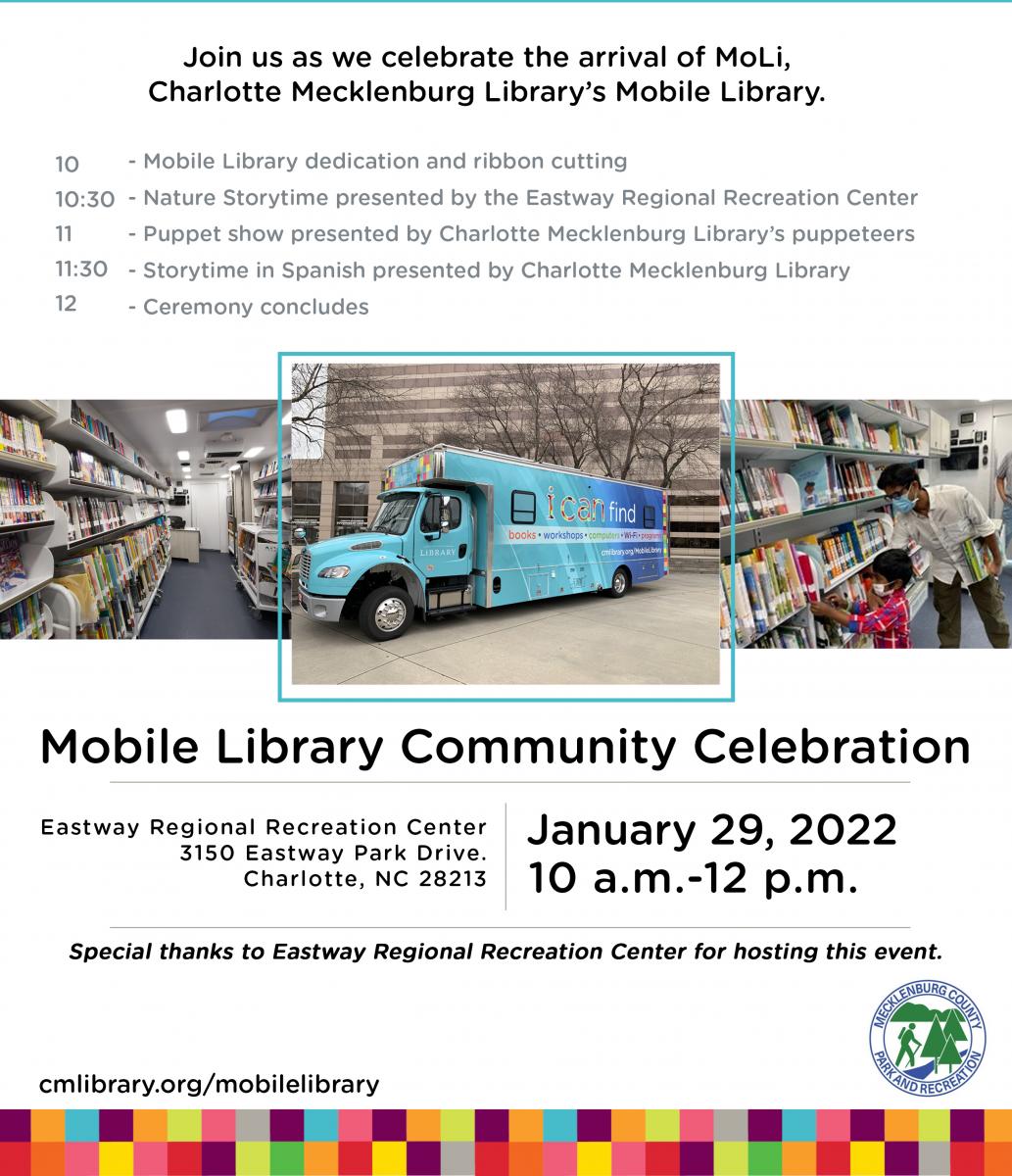
Black Lives Still Matter - Part 2
April 29, 2021
This blog was written as part of Charlotte Mecklenburg Library's Black Lives Matter program initiative. Learn more about the program and corresponding events here.
Last week the man that murdered George Floyd was found guilty by a jury of his peers, was handcuffed, and carted off to prison to await sentencing. I don't believe that people were prepared for the criminal justice system to hold Derek Chauvin accountable for the crimes he committed against George Floyd and it's quite shocking that Derek Chauvin was held responsible. It shouldn't have been, but it was. Many people call this justice, but this verdict was more about accountability. Justice wouldn't let the killing of Black bodies at the hands of police continue to go on. I believe that protesters were fully prepared to cause a stir, and rightly so, there were celebrations in the streets this time. We all breathed a collective sigh of relief when the judge read all three guilty counts, however, it should not be like this.
The trial took several weeks to deliberate, with the world waiting on bated breath. And, if it weren't for Darnella Frazier, I'm not sure we would have reached three significant guilty verdicts. For those who may not know, Frazier was a bystander on the day George Floyd was arrested. She and her 9-year-old cousin happened to be in the neighborhood, along with many other people. They decided to take out her cell phone to record the realities of Floyd's death. First off, I could not imagine the horrors they witnessed -- especially at such an early age. But what I really can't get out of my mind is that without her eyewitness account and video footage (which was the longest and most clear footage recorded that day), would the outcome of the trial be the same? Much like the footage captured of Rodney King, Frazier's video brought the truth to light and ultimately held Chauvin accountable.
Black people's shared experience dealing with the police and lack of justice or accountability is traumatic. The trauma never ends because, on the heels of our collective relief that accountability was served, there was another police shooting of a Black body — this time, a 16-year-old child. There are no words to describe the announcement of yet another Black body being shot down by police. I can gather that numb is a feeling, and outrage. Enough is enough. Reform of the police is a necessity. It will take more than just saying but actually putting it into legislation.
Since the start of Derek Chauvin's trial, there have been many interactions with police that have happened or been revealed, and it's triggering. People of color have been facing some hard realities these past few weeks. A Black Army Lieutenant, Caron Nazario, was pulled over and harassed by police in Virginia. Although complying with the officer's commands, the officers excessively pursued him and caused an uproar online from the video of the interaction that went viral. Days following the body cam footage of Lt. Caron Nazario's interaction, Daunte Wright was shot and killed by a police officer after being pulled over because he had an air freshener hanging from his rearview mirror. Not even a week after that, police body cam footage was released of a 13-year-old child with his hands up being shot and killed by Chicago police. And even since the initial writing of this blog, there are more names to add to the list of people killed at the hands of police. On top of the Chauvin trial, all these things happened simultaneously, and it's heavy.
Although heavy and traumatic, Black people continue to fight for this so-called justice. All these things are about holding people accountable because justice would require change, and change seems so far away.
True justice comes when there are no longer cases like George Floyd's and all the men and women whose cases came before his and all the cases of the people who don't make national headlines. Black lives still matter.
To read more about the social justice movement, criminal justice, excessive force and the police, check out our Justice and Accountability booklist on the Library's website.
Access the Justice and Accountability Booklist
--
This blog was written and a collaboration of thoughts by De'Trice Fox, adult services librarian; Amrita Patel, library outreach coordinator; and Alesha Lackey, children's services manager.
Stories told through Sign Language

Reading in Color - Small Start, Huge Impact
April 30, 2021
The Reading in Color program began in 2016 at Charlotte Mecklenburg Library. Created by Outreach Coordinator, Jasmine McNeil, this started out as a weekly book club with six fifth-grade girls at an inner-city elementary school. The objective was to create a book club that promoted diverse characters in a positive light as a way to connect with reluctant readers and to increase literacy skills in students that were behind.
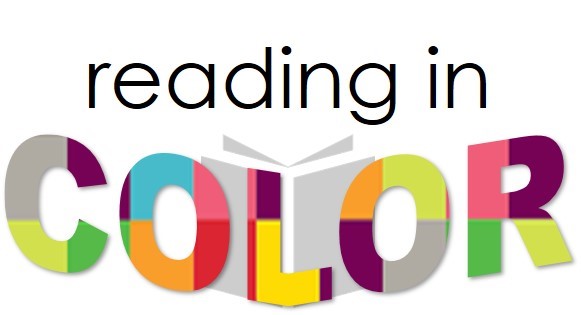 As the program grew, so did the popularity and the number of schools requesting it. In 2018, Reading in Color was branded and a team of library staff was formed to meet the need at additional schools. The main community partner for this successful program is Communities in Schools.
As the program grew, so did the popularity and the number of schools requesting it. In 2018, Reading in Color was branded and a team of library staff was formed to meet the need at additional schools. The main community partner for this successful program is Communities in Schools.
Each week, students ranging in grades third through eight, received a weekly book club that not only helped with literacy skills but focused on self-esteem and social-emotional learning. From games and activities, group work and open discussions, students were able to express themselves and collaborate with their peers.
In 2020, Reading in Color won the Mayor’s Mentoring Alliance Award, for “Best Mentoring Collaboration” for Charlotte Mecklenburg Library and Communities in Schools.
Since the pandemic, the Reading in Color team has shifted its focus from book clubs to social-emotional learning activities and providing Communities in Schools families with community and library resources. It was necessary to shift the focus with the constant change of virtual learning. The team wanted to find a way to continue to engage with the students previously served, as well as new students, without adding to their “burnout” of virtual learning.
The team began one-on-one Reading Buddy sessions by request. The books chosen continue to feature and highlight characters of color. “Reading in Color Shorts” was created as short videos that provide either a recommended book that features characters of color or highlighted library resources. These “shorts” are shared monthly with community partners.
As the team plans for the upcoming school year, there is hope that in-person programming will begin, book clubs will resume, as well as the expansion of programs created during the pandemic.
A special shout out to the ladies that continue to make this small team a huge success and an even greater impact in the community:
Jasmine McNeil (Outreach), Sydney Porter (Plaza Midwood Library), LaShai Thompson (Independence Regional), Janai Thompson (Allegra Westbooks Regional), Amrita Patel (Outreach) and Karina Blackburn (University City).
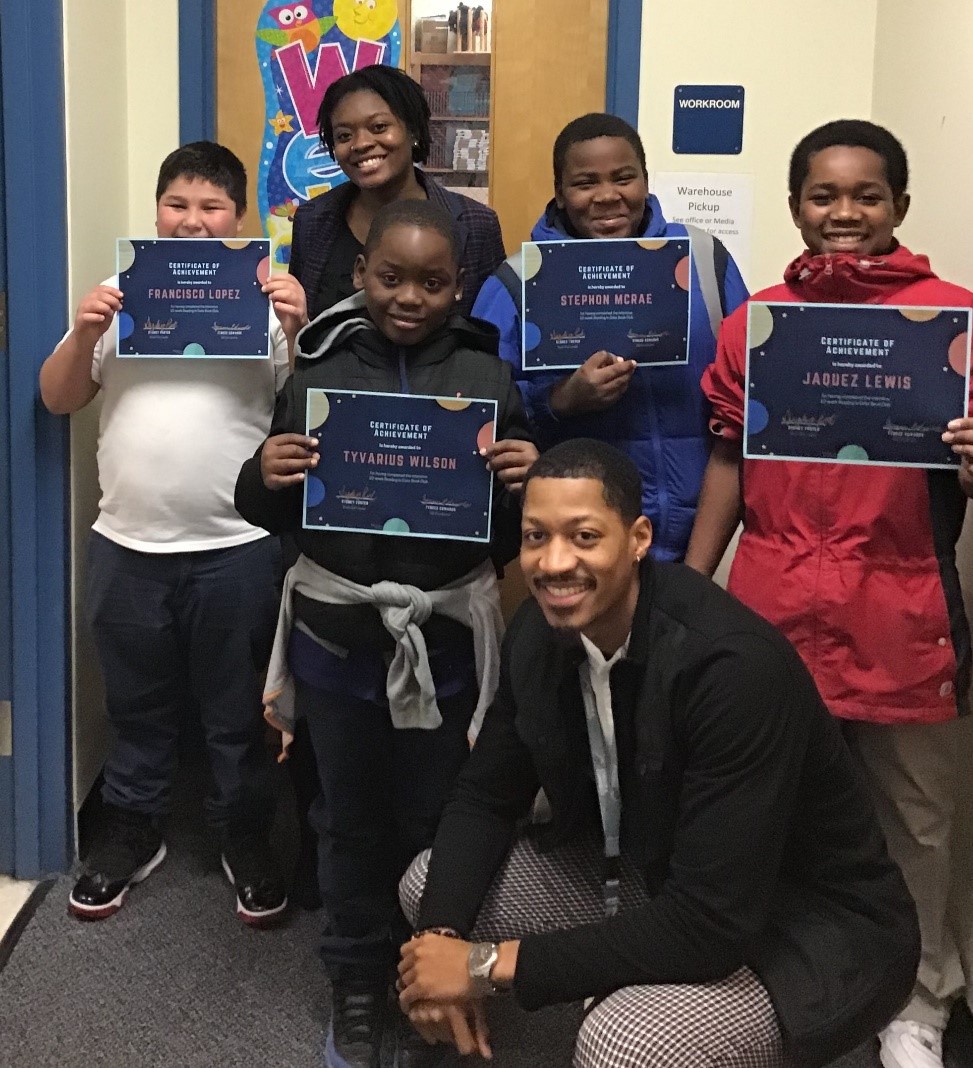
Check out the Reading in Color impact video here.
Also, keep up on our monthly Reading in Color shorts by visiting the Reading in Color Playlist on the Charlotte Mecklenburg Library’s YouTube Page.
--
This blog was written by Jasmine McNeil, outreach coordinator, at Charlotte Mecklenburg Library
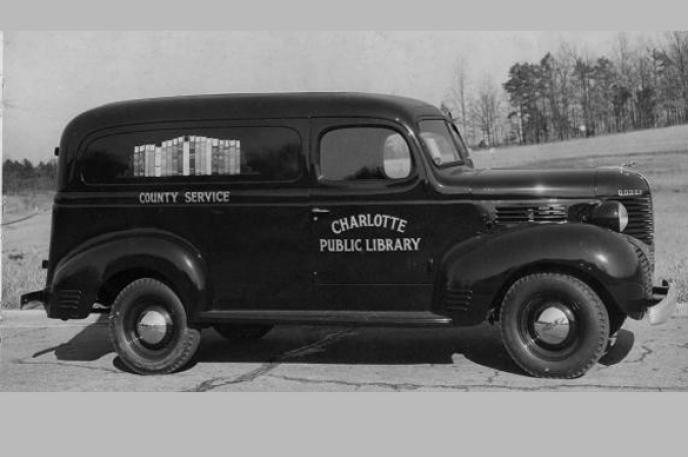
Batman may have the Batmobile, but the Charlotte Mecklenburg Library has the Bookmobile!
January 20, 2022
Bookmobiles are an effective way to provide equitable access to library resources and services in rural communities. These “libraries on wheels” visit schools, retirement centers, and other hard-to-reach communities that may otherwise not have access to a library.
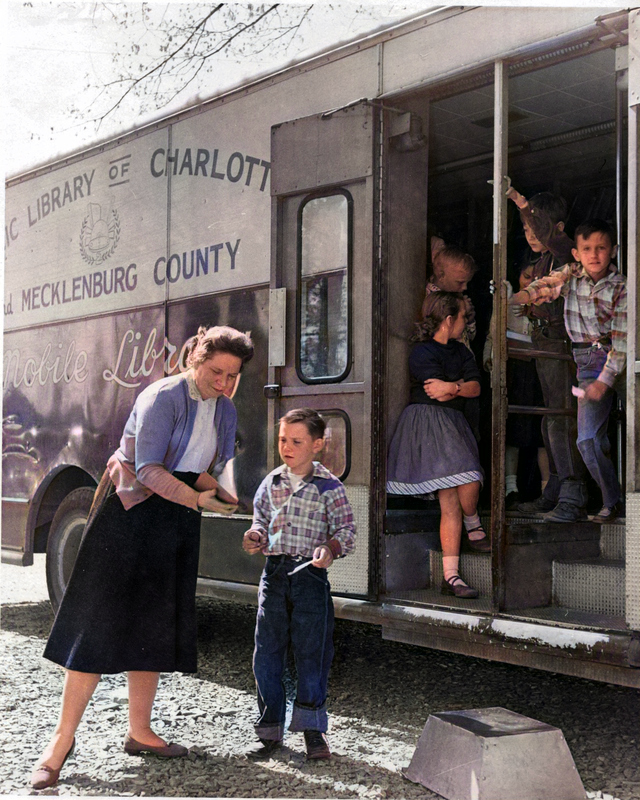
Colorized image of the Public Library of Charlotte’s bookmobile, 1966
Historical Context of the Bookmobile Program
“...the bookmobile rolls along through this rural State, and in its wake wells of water for thirsty minds spring up in the desert...” -Charlotte Observer, January 17, 1937
In 1937, nearly two million North Carolina residents lived in “literary deserts,” areas where books and other reading materials are difficult to obtain. Only 87 public libraries existed in the state at that time, with a combined collection of 744,369 volumes. In response to these startling statistics, The Citizens Library Movement sought to improve and create access to library books through a mobile library service. They partnered with the North Carolina Library Commission to request $150,000 in state funds to fuel their efforts.
State aid not only supported the mobile library program but also covered operational expenses for libraries that could only afford to stay open for several hours a week. The funds helped increase and stabilize collection management budgets as well. [1]
Where the Rubber Meets the Road, 1937-1942
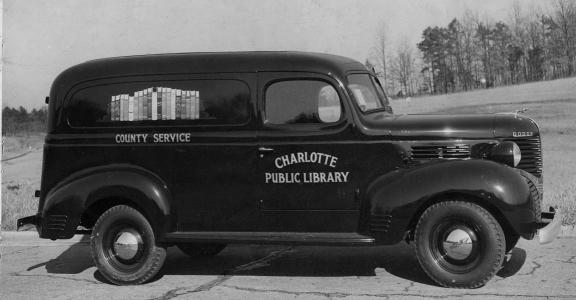
Charlotte Public Library bookmobile, c1937
“...And there are those who would stand out and shade their eyes down the dusty roads and watch for the advent of a bookmobile with anticipation as keen as a kid looking for Santa Claus.” -Charlotte Observer, February 4, 1939
Charlotte's first bookmobile was introduced in December 1937 under the leadership of James E. Gourley, Director of the Charlotte Public Library. The North Carolina Library Commission funded a two-month trial of the service, which allowed library users to borrow “as many books as your family can read in two weeks.” The bookmobile stacked its shelves with approximately 1,000 books from the central branch and journeyed to rural areas, such as Croft, Caldwell, Cornelius, Davidson, and Huntersville, with the hope of extending services to other rural communities after the two-month trial ended. [2]
Gaston County heavily influenced the adoption of the mobile library in Mecklenburg County, proving the importance of “the distribution of books by bookmobile to every nook and cranny of the county,” a conclusion also made by the Charlotte Public Library. [3]
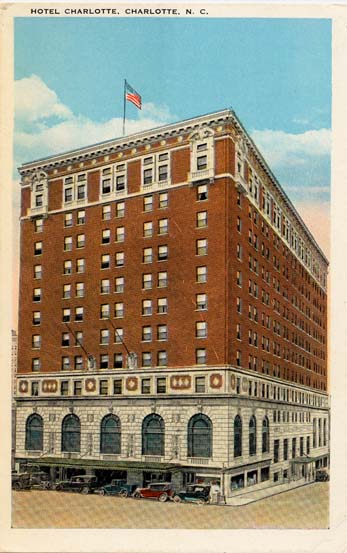
Hotel Charlotte, 1928. Photo courtesy of the Charlotte Mecklenburg Library.
The mobile library experiment proved to be successful, as the Charlotte community fiercely loved the bookmobile. In March 1938 after the trial ended, Governor Hoey addressed a group of “library enthusiasts” from twenty-eight North Carolina counties at Hotel Charlotte. During this meeting, notable speakers, including Charlotte Public Library’s James E. Gourley, requested an annual sum of $300,000 for two years to “equalize public library service in the State.” [4]
Governor Hoey used the state’s shocking illiteracy rates as the driving argument for the continuation of the mobile library service, which visited the rural communities where illiteracy rates were highest:
“Since more than one half of the State’s population live in the rural communities, anything that will increase the reading in those communities will be of tremendous value...and the extension of adequate library facilities into the rural areas will do much toward advancing the interests of North Carolina.” - Governor Hoey, Charlotte Observer, March 27, 1938
Successful in their efforts, the bookmobile program continued. Charlotte Public Library received two bookmobiles. By the end of 1938, the Library established 37 deposit stations in homes and stores around Mecklenburg County. [5]
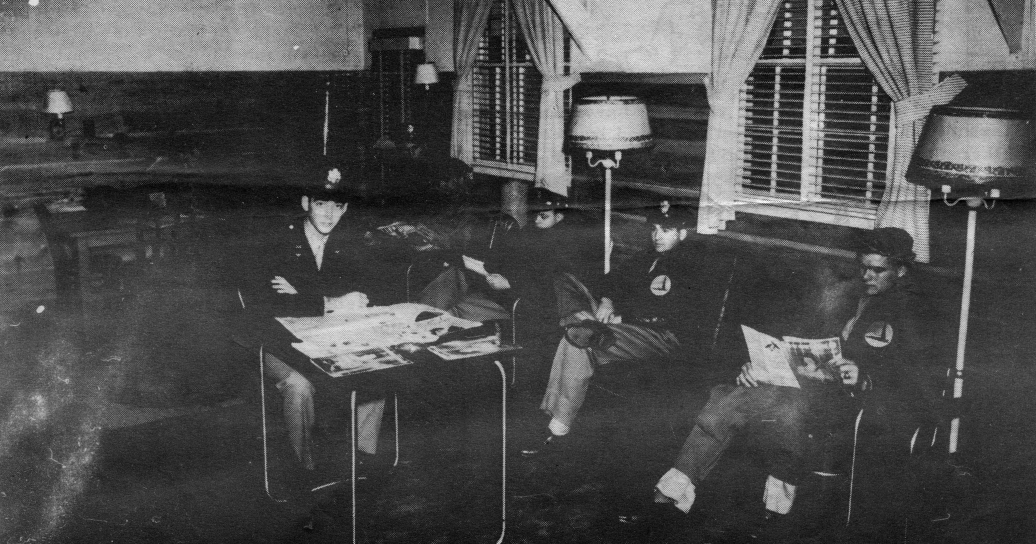
Flying Officers reading on base, November 1942. Photo courtesy of Morris Code, Vol.1, No.17.
“If the Charlotte airbase soldiers become stoop-shouldered and begin wearing horn-rimmed glasses, you can blame the bookmobile...” -Charlotte Observer, September 17, 1941
In addition to serving rural communities, the Library’s bookmobile also served soldiers at the airbase on the outskirts of Charlotte as part of the “Keep ‘em Reading” campaign. (The airbase became known as Morris Field in 1942 to honor Major William C. Morris.) This bookmobile, provided by the Works Progress Administration (WPA) in July 1941 and driven by Librarian Carolyn Gregory, was one of two bookmobiles used by the Library at that time. The military men appreciated Gregory’s memory of their names and book preferences. She frequently mentioned the airbase was her favorite stop of all. Her nickname eventually became “Ma,” a name and role she cherished at the base. [6]
The bookmobile visited the airbase every Wednesday and Saturday. Among the most popular books included: “adventure novels of Zane Grey and James Oliver Curwood, the flashing swordplay of Rafael Sabatini, travel, and textbooks in trigonometry, geometry, physics, radio, electricity, history, and Spanish grammar.” [7]
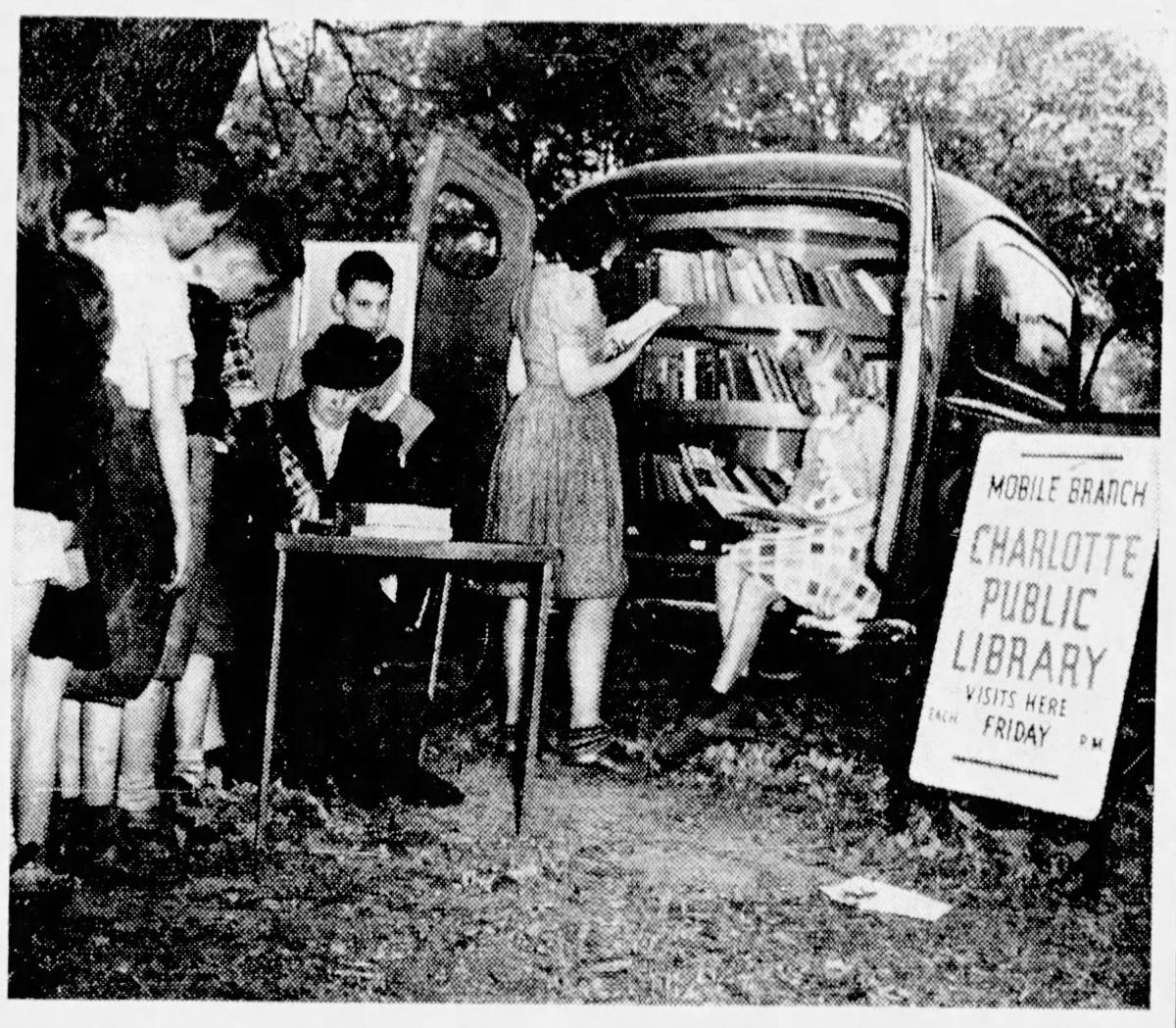
Photo courtesy of the Charlotte Observer, November 30, 1941.
Bookmobiles greatly increased the circulation of the Library’s materials. During the week of November 20, 1941, alone, circulation nearly doubled, thanks to Library Director Hoyt Galvin placing signs that said “Mobile Branch, Charlotte Public library, Visits Here” along the bookmobile’s regular routes. [8] From 1937-to 1941, nearly 7,000 books circulated due to the efforts of the mobile library service. [9]
The winter months proved more difficult for the bookmobile due to icy road conditions. Because the mobile library was a “fresh air business,” Library staff had to get creative when dealing with windy weather. Librarian Carolyn Gregory and Director Hoyt Galvin designed a makeshift wind-breaking device to place behind the card table she set up at each stop while on duty. It consisted of three fire screens and an army blanket. [10]
Rocky Road, 1943-1948
In October 1942, the WPA withdrew the bookmobile used by the Charlotte Public Library for 15 months because of WPA staff shortages and increasing demand from other WPA-related projects. The bookmobile had performed wonderfully in the Charlotte community, logging hundreds of new cardholders and thousands of borrowed books. [11]
Several months later in January 1943, the Women’s Auxiliary Board of Charlotte Memorial Hospital purchased a bookmobile; the Library supplied the books, and the Auxiliary provided volunteer drivers. [12] By April 1945, the Auxiliary volunteers donated a portion of nearly 9,000 hours (shared among receptionists, a sewing group, and the chapel committee) to the Charlotte Public Library’s bookmobile service. [13]

Marcellus Turner, Charlotte Mecklenburg Library CEO/Chief Librarian, with a check from the Alcoholic Beverage Control Commission, June 2021. Photo courtesy of the Charlotte Mecklenburg Library.
The General Assembly authorized an election in 1947 for Mecklenburg County to vote for the Alcoholic Beverage Control (ABC) department to contribute five percent of its profits to the Library. The Library saw its first check-in in October 1948, which ultimately funded the purchase of two bookmobiles in 1949. Both bookmobiles cost a grand total of $27,500. [14]
One of the bookmobiles replaced the nine-year-old bookmobile lovingly named Puddle-Jumper, and the other was designated for the Black community. [15] The Library still receives an annual payment from the ABC department to this day.
Bookmobiles for All, 1948-1966
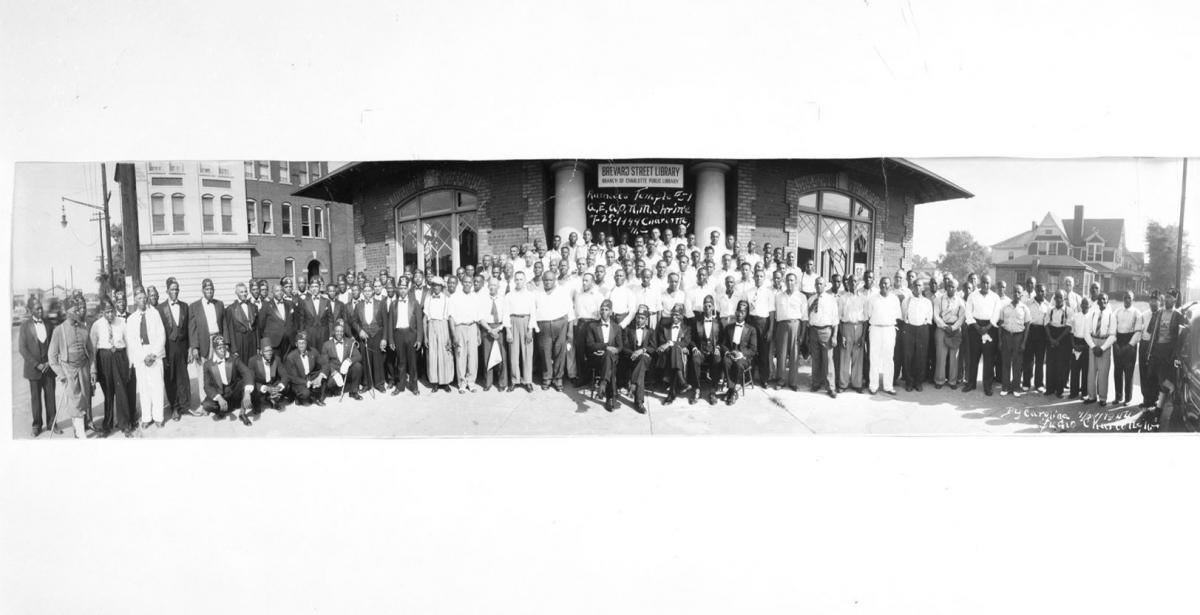
Brevard Street Library, 1944. Photo courtesy of the Charlotte Mecklenburg Library.
Library Director Hoyt Galvin hoped to use the additional funds from the ABC department to improve the Brevard Street Library (1905-1961), the first public library for the Black community in the state. He hired Allegra Westbrooks, the first African American public library supervisor in North Carolina, in 1947.
At that time, only two Black libraries existed in Mecklenburg County--Brevard Street and its “sub-branch” on Oaklawn Avenue. Ms. Westbrooks advocated for the purchase of a bookmobile for the Black community, a dream that came true on December 5, 1949. [16]
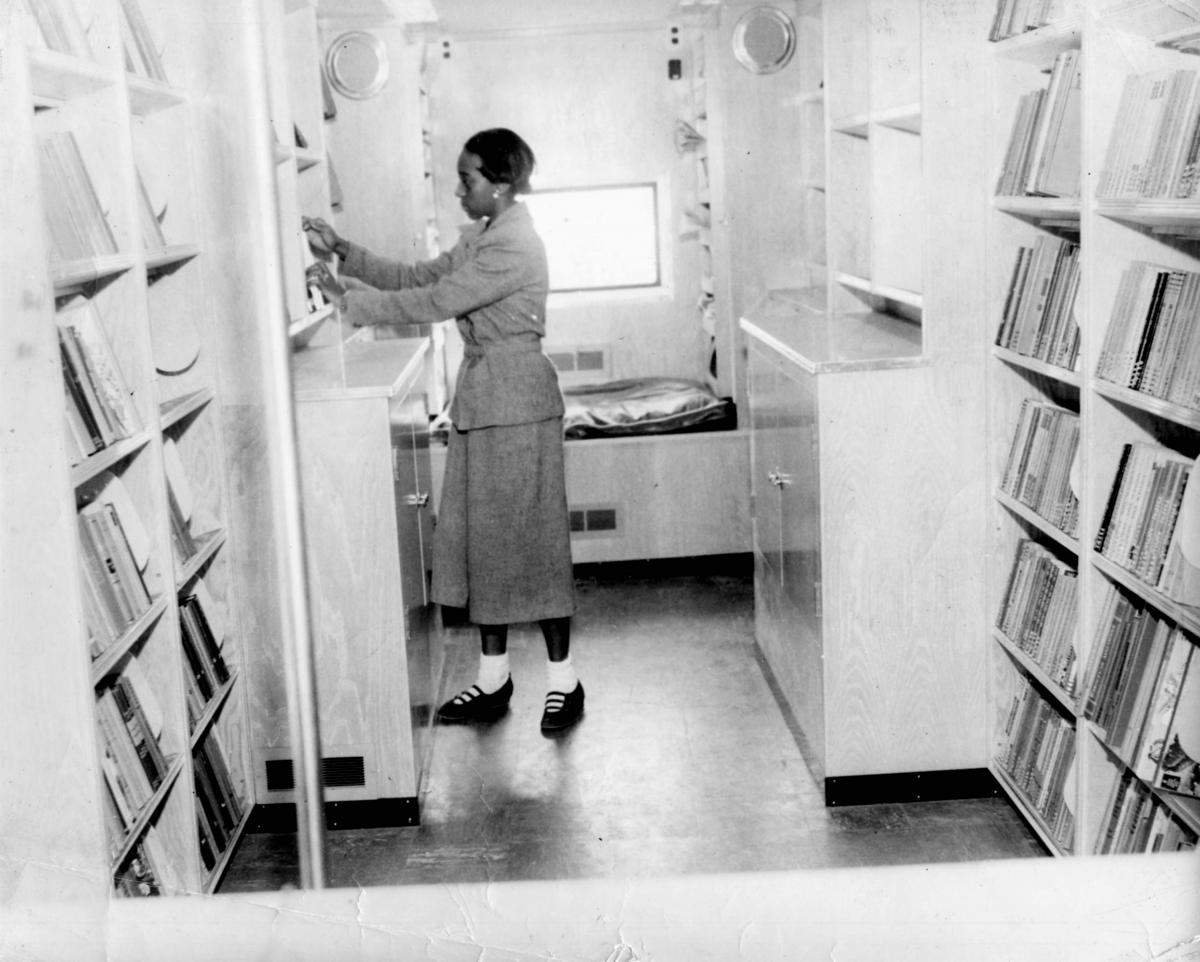
Interior of the bookmobile, 1966. Photo courtesy of the Charlotte Mecklenburg Library.
The bookmobile had the capability to handle about 3,000 books and was fully operational with adequate lighting, reading space, and enough power to project motion pictures. [17] Ms. Westbrooks' proposed bookmobile route included stops at 12th and Alexander Streets, West Hill and Mint Streets, Beatty’s Ford Road and Mattoon Street, Grier Heights, Statesville Terrace, York Road, and multiple other predominately Black neighborhoods in the county. [18]
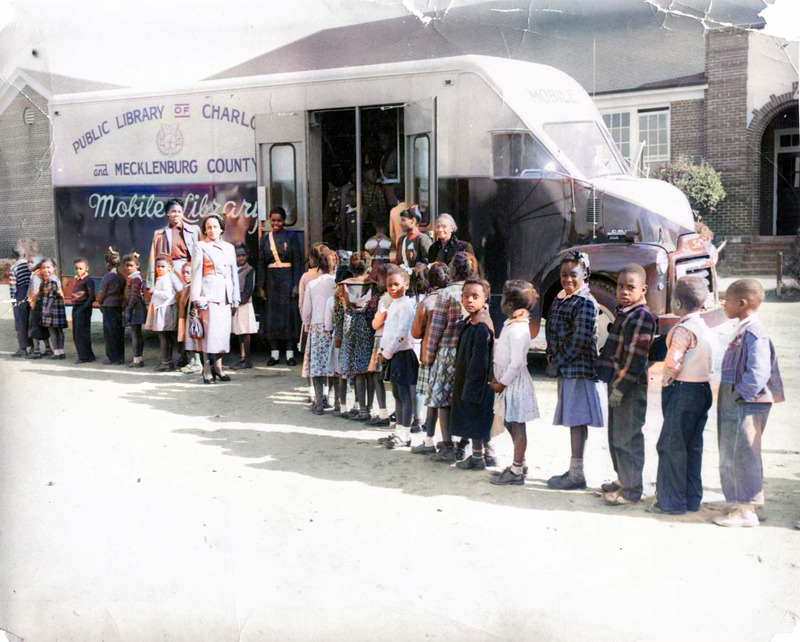
Colorized image of the PLCMC bookmobile, 1966. Photo courtesy of the Charlotte Mecklenburg Library.
“It is gratifying, when you’ll be on the street and see somebody, and they say, 'I used the bookmobile. I want you to meet my four children. I insist that they read'.” -Allegra Westbrooks
Ms. Westbrooks influenced countless people in the Black community to go to libraries through her public service. People remember her visiting them with a bookmobile to inspire them to read. She would also pick up books that her patrons requested at Main Library once a week.
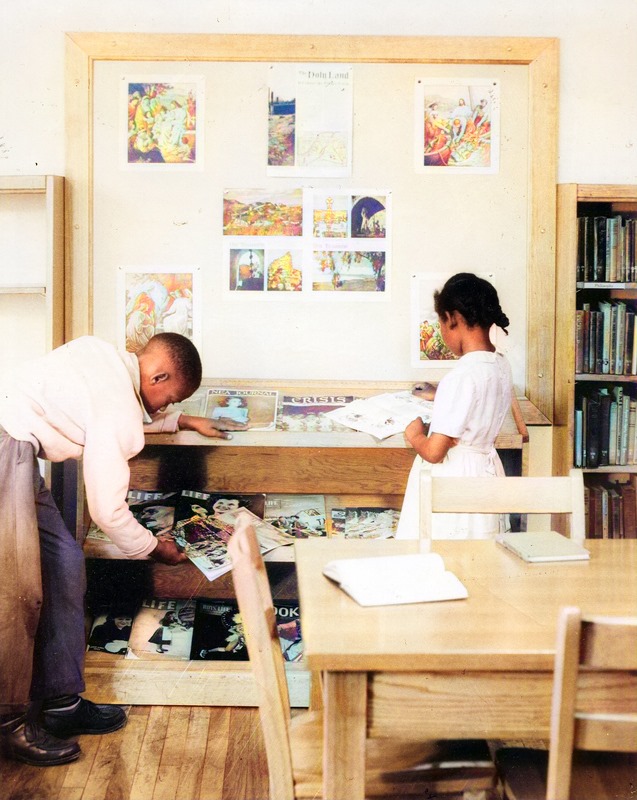
Brevard Street Library, c1947
The bookmobile resulted in increased circulation of Brevard Street Library materials, with November 1948 monthly statistics totaling 3,445, and November 1949 monthly statistics totaling 4,180. The 2,500 square foot branch proved too tiny for the frequent patrons, so Ms. Westbrooks recalls “the crowded conditions in the library make it necessary to ask persons to check out books and move on so that others may enter.” [19]
Charlotte’s public library system officially integrated in November 1956, but the Brevard Street Branch continued to operate until December of 1961 when it was closed and demolished as part of the Brooklyn urban redevelopment project. [20]
Back to Square One, 1966-2021
One librarian who operated a bookmobile throughout the 1950s described the work as “glorified missionary work,” and that she “couldn’t do better business or have a greater following if she had an ice cream wagon.” [21] The overwhelming popularity of the bookmobiles made the retirement of the two bookmobiles in 1966 extra disappointing.
The decision was not easy to make, but due to the growing expenses to operate the vehicles, the Library had little choice in the matter.
Looking “Foreword,” 2021 and beyond

Mobile Library, 2021. Photo courtesy of Charlotte Mecklenburg Library.
Charlotte Mecklenburg Library places great importance on improving lives and building a stronger community. Director Caitlin Moen described the mobile library service in an official statement: “The new Mobile Library expands and deepens the Library’s ability to reach into high need areas of the community, providing access to free resources, programs and technology, particularly where limited physical or digital access to Library services exist. This access will help create pathways for citizens to learn and grow, gaining success in school, in their careers, and beyond.”
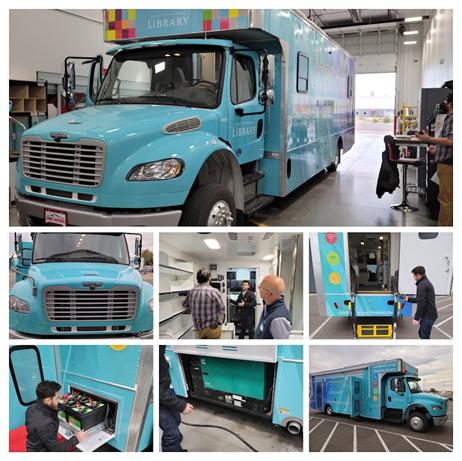
Collage of the new Mobile Library, 2021. Photo courtesy of Charlotte Mecklenburg Library.
Our new bookmobile offers the following features:
- Shelving for a sizeable collection.
- An entrance and exit for easy customer flow through the vehicle
- An ADA compatible wheelchair lift
- Four mobile collection carts for pop up collections and displays
- A mobile technology cart to be equipped with laptops, Chromebooks, tablets and other technology.
- An air filtration system to help mitigate COVID-19 and other pathogens
- An onboard and external A/V system equipped with an external 65-inch display, and two additional displays inside.
- A speaker system with microphones for programming both inside and outside the vehicle.
- A diesel generator and a power inverter supported by four solar panels on the roof of the vehicle. This means our vehicle comes with lots of power and plugs for extra flexibility!
- 360-degree backup and side cameras to ensure safe parking and navigation.
The Mobile Library of today strives to provide equitable access to the underserved and underrepresented communities of Mecklenburg County. In the words of William Shakespeare, “What’s past is prologue.” And so, Charlotte Mecklenburg Library’s bookmobile journey continues!
--- This blog was written by Sydney Carroll, Archivist of the Robinson-Spangler Carolina Room.
Footnotes
[1] Charlotte Observer (Charlotte, North Carolina), January 17, 1937: 63. NewsBank: America's News – Historical and Current. https://infoweb.newsbank.com/apps/news/document-view?p=AMNEWS&docref=image/v2%3A11260DC9BB798E30%40EANX-NB-15E24F7AC23928DF%402428551-15E3EBB49AF23875%4062-15E3EBB49AF23875%40.
[2] Charlotte Observer (Charlotte, North Carolina), December 2, 1937: 3. NewsBank: America's News – Historical and Current. https://infoweb.newsbank.com/apps/news/document-view?p=AMNEWS&docref=image/v2%3A11260DC9BB798E30%40EANX-NB-15E24F7E8E938003%402428870-15E3EBB57AE3E5BB%402-15E3EBB57AE3E5BB%40.
[3] Charlotte Observer (Charlotte, North Carolina), July 28, 1937: 10. NewsBank: America's News – Historical and Current. https://infoweb.newsbank.com/apps/news/document-view?p=AMNEWS&docref=image/v2%3A11260DC9BB798E30%40EANX-NB-15E24F82B2F74FAF%402428743-15E3EBC385AB9ACC%409-15E3EBC385AB9ACC%40.
[4] Charlotte Observer (Charlotte, North Carolina), March 27, 1938: 23. NewsBank: America's News – Historical and Current. https://infoweb.newsbank.com/apps/news/document-view?p=AMNEWS&docref=image/v2%3A11260DC9BB798E30%40EANX-NB-15E24F7FF075EB0B%402428985-15E3EBBDE645BB68%4022-15E3EBBDE645BB68%40.
[5] Ryckman, Patricia. “Public Library of Charlotte and Mecklenburg County: A Century of Service.” Charlotte, N.C.: Public Library of Charlotte and Mecklenburg County, 1989.
[6] Charlotte Observer (Charlotte, North Carolina), February 10, 1942: 6. NewsBank: America's News – Historical and Current. https://infoweb.newsbank.com/apps/news/document-view?p=AMNEWS&docref=image/v2%3A11260DC9BB798E30%40EANX-NB-15E24F969D1C3A7C%402430401-15E3EBDA369620FA%405-15E3EBDA369620FA%40.
[7] Ibid.
[8] Charlotte Observer (Charlotte, North Carolina), November 20, 1941: 12. NewsBank: America's News – Historical and Current. https://infoweb.newsbank.com/apps/news/document-view?p=AMNEWS&docref=image/v2%3A11260DC9BB798E30%40EANX-NB-15E24F9595CCECED%402430319-15E3EBE530C592C3%4011-15E3EBE530C592C3%40.
[9] Charlotte Observer (Charlotte, North Carolina), November 30, 1941: 15. NewsBank: America's News – Historical and Current. https://infoweb.newsbank.com/apps/news/document-view?p=AMNEWS&docref=image/v2%3A11260DC9BB798E30%40EANX-NB-15E24F9596838AD7%402430329-15E3EBE548945201%4014-15E3EBE548945201%40.
[10] Ibid.
[11] Charlotte Observer (Charlotte, North Carolina), October 16, 1942: 30. NewsBank: America's News – Historical and Current. https://infoweb.newsbank.com/apps/news/document-view?p=AMNEWS&docref=image/v2%3A11260DC9BB798E30%40EANX-NB-15E24F99CDD33BB5%402430649-15E3EBE6CF4E4B32%4029-15E3EBE6CF4E4B32%40.
[12] Charlotte Observer (Charlotte, North Carolina), January 21, 1943: 11. NewsBank: America's News – Historical and Current. https://infoweb.newsbank.com/apps/news/document-view?p=AMNEWS&docref=image/v2%3A11260DC9BB798E30%40EANX-NB-15E3F0BF73D3C837%402430746-15E3EBDBA7D7A791%4010-15E3EBDBA7D7A791%40.
[13] Charlotte Observer (Charlotte, North Carolina), April 20, 1945: 21. NewsBank: America's News – Historical and Current. https://infoweb.newsbank.com/apps/news/document-view?p=AMNEWS&docref=image/v2%3A11260DC9BB798E30%40EANX-NB-15E3F0D08E6DF4A7%402431566-1604902CAFDF846A%4020-1604902CAFDF846A%40.
[14] Ryckman, Patricia. “Public Library of Charlotte and Mecklenburg County: A Century of Service.”
[15] Charlotte Observer (Charlotte, North Carolina), October 19, 1948: 12. NewsBank: America's News – Historical and Current. https://infoweb.newsbank.com/apps/news/document-view?p=AMNEWS&docref=image/v2%3A11260DC9BB798E30%40EANX-NB-15E24FAC7192B6AB%402432844-1604904181FE53BF%4011-1604904181FE53BF%40.
[16] Charlotte Observer (Charlotte, North Carolina), December 23, 1949: 16. NewsBank: America's News – Historical and Current. https://infoweb.newsbank.com/apps/news/document-view?p=AMNEWS&docref=image/v2%3A11260DC9BB798E30%40EANX-NB-15E24F9B8A73B044%402433274-1604905606B5F952%4015-1604905606B5F952%40.
[17] Charlotte Observer (Charlotte, North Carolina), April 28, 1949: 20. NewsBank: America's News – Historical and Current. https://infoweb.newsbank.com/apps/news/document-view?p=AMNEWS&docref=image/v2%3A11260DC9BB798E30%40EANX-NB-15E24FA9547A0DE3%402433035-1604904B5256A446%4019-1604904B5256A446%40.
[18] Charlotte Observer (Charlotte, North Carolina), March 9, 1949: 15. NewsBank: America's News – Historical and Current. https://infoweb.newsbank.com/apps/news/document-view?p=AMNEWS&docref=image/v2%3A11260DC9BB798E30%40EANX-NB-15E24FA8F7A9DD01%402432985-16049049D4EA84A9%4014-16049049D4EA84A9%40.
[19] Charlotte Observer (Charlotte, North Carolina), December 23, 1949
[20] Ryckman, Patricia. “Public Library of Charlotte and Mecklenburg County: A Century of Service.”
[21] Charlotte Observer (Charlotte, North Carolina), June 17, 1960: 39. NewsBank: America's News – Historical and Current. https://infoweb.newsbank.com/apps/news/document-view?p=AMNEWS&docref=image/v2%3A11260DC9BB798E30%40EANX-NB-15E24F22B5DE010C%402437103-15E249FF0AF35320%4038-15E249FF0AF35320%40.
Bibliography
Charlotte Observer (Charlotte, North Carolina), February 4, 1939: 6. NewsBank: America's News – Historical and Current. https://infoweb.newsbank.com/apps/news/document-view?p=AMNEWS&docref=image/v2%3A11260DC9BB798E30%40EANX-NB-15F6614CD140FE6A%402429299-15F6012A55D03F72%405-15F6012A55D03F72%40.
Charlotte Observer (Charlotte, North Carolina), September 17, 1941: 13. NewsBank: America's News – Historical and Current. https://infoweb.newsbank.com/apps/news/document-view?p=AMNEWS&docref=image/v2%3A11260DC9BB798E30%40EANX-NB-15E24F94E4E49118%402430255-15E3EBE18E7A4886%4012-15E3EBE18E7A4886%40.
Charlotte Observer (Charlotte, North Carolina), July 29, 1948: 27. NewsBank: America's News – Historical and Current. https://infoweb.newsbank.com/apps/news/document-view?p=AMNEWS&docref=image/v2%3A11260DC9BB798E30%40EANX-NB-15E3F0DFC7166689%402432762-1604903ACEB0627A%4026-1604903ACEB0627A%40.
Charlotte Observer (Charlotte, North Carolina), March 9, 1949: 28. NewsBank: America's News – Historical and Current. https://infoweb.newsbank.com/apps/news/document-view?p=AMNEWS&docref=image/v2%3A11260DC9BB798E30%40EANX-NB-15E24FA8F7A9DD01%402432985-16049049D591D32B%4027-16049049D591D32B%40.
Charlotte Observer (Charlotte, North Carolina), March 24, 1949: 18. NewsBank: America's News – Historical and Current. https://infoweb.newsbank.com/apps/news/document-view?p=AMNEWS&docref=image/v2%3A11260DC9BB798E30%40EANX-NB-15E24FA8F8C6A1B5%402433000-16049049F23A80AA%4017-16049049F23A80AA%40.

Batman may have the Batmobile, but the Charlotte Mecklenburg Library has the Bookmobile!
January 20, 2022
Bookmobiles are an effective way to provide equitable access to library resources and services in rural communities. These “libraries on wheels” visit schools, retirement centers, and other hard-to-reach communities that may otherwise not have access to a library.

Colorized image of the Public Library of Charlotte’s bookmobile, 1966
Historical Context of the Bookmobile Program
“...the bookmobile rolls along through this rural State, and in its wake wells of water for thirsty minds spring up in the desert...” -Charlotte Observer, January 17, 1937
In 1937, nearly two million North Carolina residents lived in “literary deserts,” areas where books and other reading materials are difficult to obtain. Only 87 public libraries existed in the state at that time, with a combined collection of 744,369 volumes. In response to these startling statistics, The Citizens Library Movement sought to improve and create access to library books through a mobile library service. They partnered with the North Carolina Library Commission to request $150,000 in state funds to fuel their efforts.
State aid not only supported the mobile library program but also covered operational expenses for libraries that could only afford to stay open for several hours a week. The funds helped increase and stabilize collection management budgets as well. [1]
Where the Rubber Meets the Road, 1937-1942

Charlotte Public Library bookmobile, c1937
“...And there are those who would stand out and shade their eyes down the dusty roads and watch for the advent of a bookmobile with anticipation as keen as a kid looking for Santa Claus.” -Charlotte Observer, February 4, 1939
Charlotte's first bookmobile was introduced in December 1937 under the leadership of James E. Gourley, Director of the Charlotte Public Library. The North Carolina Library Commission funded a two-month trial of the service, which allowed library users to borrow “as many books as your family can read in two weeks.” The bookmobile stacked its shelves with approximately 1,000 books from the central branch and journeyed to rural areas, such as Croft, Caldwell, Cornelius, Davidson, and Huntersville, with the hope of extending services to other rural communities after the two-month trial ended. [2]
Gaston County heavily influenced the adoption of the mobile library in Mecklenburg County, proving the importance of “the distribution of books by bookmobile to every nook and cranny of the county,” a conclusion also made by the Charlotte Public Library. [3]

Hotel Charlotte, 1928. Photo courtesy of the Charlotte Mecklenburg Library.
The mobile library experiment proved to be successful, as the Charlotte community fiercely loved the bookmobile. In March 1938 after the trial ended, Governor Hoey addressed a group of “library enthusiasts” from twenty-eight North Carolina counties at Hotel Charlotte. During this meeting, notable speakers, including Charlotte Public Library’s James E. Gourley, requested an annual sum of $300,000 for two years to “equalize public library service in the State.” [4]
Governor Hoey used the state’s shocking illiteracy rates as the driving argument for the continuation of the mobile library service, which visited the rural communities where illiteracy rates were highest:
“Since more than one half of the State’s population live in the rural communities, anything that will increase the reading in those communities will be of tremendous value...and the extension of adequate library facilities into the rural areas will do much toward advancing the interests of North Carolina.” - Governor Hoey, Charlotte Observer, March 27, 1938
Successful in their efforts, the bookmobile program continued. Charlotte Public Library received two bookmobiles. By the end of 1938, the Library established 37 deposit stations in homes and stores around Mecklenburg County. [5]

Flying Officers reading on base, November 1942. Photo courtesy of Morris Code, Vol.1, No.17.
“If the Charlotte airbase soldiers become stoop-shouldered and begin wearing horn-rimmed glasses, you can blame the bookmobile...” -Charlotte Observer, September 17, 1941
In addition to serving rural communities, the Library’s bookmobile also served soldiers at the airbase on the outskirts of Charlotte as part of the “Keep ‘em Reading” campaign. (The airbase became known as Morris Field in 1942 to honor Major William C. Morris.) This bookmobile, provided by the Works Progress Administration (WPA) in July 1941 and driven by Librarian Carolyn Gregory, was one of two bookmobiles used by the Library at that time. The military men appreciated Gregory’s memory of their names and book preferences. She frequently mentioned the airbase was her favorite stop of all. Her nickname eventually became “Ma,” a name and role she cherished at the base. [6]
The bookmobile visited the airbase every Wednesday and Saturday. Among the most popular books included: “adventure novels of Zane Grey and James Oliver Curwood, the flashing swordplay of Rafael Sabatini, travel, and textbooks in trigonometry, geometry, physics, radio, electricity, history, and Spanish grammar.” [7]

Photo courtesy of the Charlotte Observer, November 30, 1941.
Bookmobiles greatly increased the circulation of the Library’s materials. During the week of November 20, 1941, alone, circulation nearly doubled, thanks to Library Director Hoyt Galvin placing signs that said “Mobile Branch, Charlotte Public library, Visits Here” along the bookmobile’s regular routes. [8] From 1937-to 1941, nearly 7,000 books circulated due to the efforts of the mobile library service. [9]
The winter months proved more difficult for the bookmobile due to icy road conditions. Because the mobile library was a “fresh air business,” Library staff had to get creative when dealing with windy weather. Librarian Carolyn Gregory and Director Hoyt Galvin designed a makeshift wind-breaking device to place behind the card table she set up at each stop while on duty. It consisted of three fire screens and an army blanket. [10]
Rocky Road, 1943-1948
In October 1942, the WPA withdrew the bookmobile used by the Charlotte Public Library for 15 months because of WPA staff shortages and increasing demand from other WPA-related projects. The bookmobile had performed wonderfully in the Charlotte community, logging hundreds of new cardholders and thousands of borrowed books. [11]
Several months later in January 1943, the Women’s Auxiliary Board of Charlotte Memorial Hospital purchased a bookmobile; the Library supplied the books, and the Auxiliary provided volunteer drivers. [12] By April 1945, the Auxiliary volunteers donated a portion of nearly 9,000 hours (shared among receptionists, a sewing group, and the chapel committee) to the Charlotte Public Library’s bookmobile service. [13]

Marcellus Turner, Charlotte Mecklenburg Library CEO/Chief Librarian, with a check from the Alcoholic Beverage Control Commission, June 2021. Photo courtesy of the Charlotte Mecklenburg Library.
The General Assembly authorized an election in 1947 for Mecklenburg County to vote for the Alcoholic Beverage Control (ABC) department to contribute five percent of its profits to the Library. The Library saw its first check in October 1948, which ultimately funded the purchase of two bookmobiles in 1949. Both bookmobiles cost a grand total of $27,500. [14]
One of the bookmobiles replaced the nine-year-old bookmobile lovingly named Puddle-Jumper, and the other was designated for the Black community. [15] The Library still receives an annual payment from the ABC department to this day.
Bookmobiles for All, 1948-1966

Brevard Street Library, 1944. Photo courtesy of the Charlotte Mecklenburg Library.
Library Director Hoyt Galvin hoped to use the additional funds from the ABC department to improve the Brevard Street Library (1905-1961), the first public library for the Black community in the state. He hired Allegra Westbrooks, the first African American public library supervisor in North Carolina, in 1947.
At that time, only two Black libraries existed in Mecklenburg County--Brevard Street and its “sub-branch” on Oaklawn Avenue. Ms. Westbrooks advocated for the purchase of a bookmobile for the Black community, a dream that came true on December 5, 1949. [16]

Interior of the bookmobile, 1966. Photo courtesy of the Charlotte Mecklenburg Library.
The bookmobile had the capability to handle about 3,000 books and was fully operational with adequate lighting, reading space, and enough power to project motion pictures. [17] Ms. Westbrooks' proposed bookmobile route included stops at 12th and Alexander Streets, West Hill and Mint Streets, Beatty’s Ford Road and Mattoon Street, Grier Heights, Statesville Terrace, York Road, and multiple other predominately Black neighborhoods in the county. [18]

Colorized image of the PLCMC bookmobile, 1966. Photo courtesy of the Charlotte Mecklenburg Library.
“It is gratifying, when you’ll be on the street and see somebody, and they say, 'I used the bookmobile. I want you to meet my four children. I insist that they read'.” -Allegra Westbrooks
Ms. Westbrooks influenced countless people in the Black community to go to libraries through her public service. People remember her visiting them with a bookmobile to inspire them to read. She would also pick up books that her patrons requested at Main Library once a week.

Brevard Street Library, c1947
The bookmobile resulted in increased circulation of Brevard Street Library materials, with November 1948 monthly statistics totaling 3,445, and November 1949 monthly statistics totaling 4,180. The 2,500 square foot branch proved too tiny for the frequent patrons, so Ms. Westbrooks recalls “the crowded conditions in the library make it necessary to ask persons to check out books and move on so that others may enter.” [19]
Charlotte’s public library system officially integrated in November 1956, but the Brevard Street Branch continued to operate until December of 1961 when it was closed and demolished as part of the Brooklyn urban redevelopment project. [20]
Back to Square One, 1966-2021
One librarian who operated a bookmobile throughout the 1950s described the work as “glorified missionary work,” and that she “couldn’t do better business or have a greater following if she had an ice cream wagon.” [21] The overwhelming popularity of the bookmobiles made the retirement of the two bookmobiles in 1966 extra disappointing.
The decision was not easy to make, but due to the growing expenses to operate the vehicles, the Library had little choice in the matter.
Looking “Foreword,” 2021 and beyond

Mobile Library, 2021. Photo courtesy of Charlotte Mecklenburg Library.
Charlotte Mecklenburg Library places great importance on improving lives and building a stronger community. Director Caitlin Moen described the mobile library service in an official statement: “The new Mobile Library expands and deepens the Library’s ability to reach into high need areas of the community, providing access to free resources, programs and technology, particularly where limited physical or digital access to Library services exist. This access will help create pathways for citizens to learn and grow, gaining success in school, in their careers, and beyond.”

Collage of the new Mobile Library, 2021. Photo courtesy of Charlotte Mecklenburg Library.
Our new bookmobile offers the following features:
- Shelving for a sizeable collection.
- An entrance and exit for easy customer flow through the vehicle
- An ADA compatible wheelchair lift
- Four mobile collection carts for pop up collections and displays
- A mobile technology cart to be equipped with laptops, Chromebooks, tablets and other technology.
- An air filtration system to help mitigate COVID-19 and other pathogens
- An onboard and external A/V system equipped with an external 65-inch display, and two additional displays inside.
- A speaker system with microphones for programming both inside and outside the vehicle.
- A diesel generator and a power inverter supported by four solar panels on the roof of the vehicle. This means our vehicle comes with lots of power and plugs for extra flexibility!
- 360-degree backup and side cameras to ensure safe parking and navigation.
The Mobile Library of today strives to provide equitable access to the underserved and underrepresented communities of Mecklenburg County. In the words of William Shakespeare, “What’s past is prologue.” And so, Charlotte Mecklenburg Library’s bookmobile journey continues!
--- This blog was written by Sydney Carroll, Archivist of the Robinson-Spangler Carolina Room.
Footnotes
[1] Charlotte Observer (Charlotte, North Carolina), January 17, 1937: 63. NewsBank: America's News – Historical and Current. https://infoweb.newsbank.com/apps/news/document-view?p=AMNEWS&docref=image/v2%3A11260DC9BB798E30%40EANX-NB-15E24F7AC23928DF%402428551-15E3EBB49AF23875%4062-15E3EBB49AF23875%40.
[2] Charlotte Observer (Charlotte, North Carolina), December 2, 1937: 3. NewsBank: America's News – Historical and Current. https://infoweb.newsbank.com/apps/news/document-view?p=AMNEWS&docref=image/v2%3A11260DC9BB798E30%40EANX-NB-15E24F7E8E938003%402428870-15E3EBB57AE3E5BB%402-15E3EBB57AE3E5BB%40.
[3] Charlotte Observer (Charlotte, North Carolina), July 28, 1937: 10. NewsBank: America's News – Historical and Current. https://infoweb.newsbank.com/apps/news/document-view?p=AMNEWS&docref=image/v2%3A11260DC9BB798E30%40EANX-NB-15E24F82B2F74FAF%402428743-15E3EBC385AB9ACC%409-15E3EBC385AB9ACC%40.
[4] Charlotte Observer (Charlotte, North Carolina), March 27, 1938: 23. NewsBank: America's News – Historical and Current. https://infoweb.newsbank.com/apps/news/document-view?p=AMNEWS&docref=image/v2%3A11260DC9BB798E30%40EANX-NB-15E24F7FF075EB0B%402428985-15E3EBBDE645BB68%4022-15E3EBBDE645BB68%40.
[5] Ryckman, Patricia. “Public Library of Charlotte and Mecklenburg County: A Century of Service.” Charlotte, N.C.: Public Library of Charlotte and Mecklenburg County, 1989.
[6] Charlotte Observer (Charlotte, North Carolina), February 10, 1942: 6. NewsBank: America's News – Historical and Current. https://infoweb.newsbank.com/apps/news/document-view?p=AMNEWS&docref=image/v2%3A11260DC9BB798E30%40EANX-NB-15E24F969D1C3A7C%402430401-15E3EBDA369620FA%405-15E3EBDA369620FA%40.
[7] Ibid.
[8] Charlotte Observer (Charlotte, North Carolina), November 20, 1941: 12. NewsBank: America's News – Historical and Current. https://infoweb.newsbank.com/apps/news/document-view?p=AMNEWS&docref=image/v2%3A11260DC9BB798E30%40EANX-NB-15E24F9595CCECED%402430319-15E3EBE530C592C3%4011-15E3EBE530C592C3%40.
[9] Charlotte Observer (Charlotte, North Carolina), November 30, 1941: 15. NewsBank: America's News – Historical and Current. https://infoweb.newsbank.com/apps/news/document-view?p=AMNEWS&docref=image/v2%3A11260DC9BB798E30%40EANX-NB-15E24F9596838AD7%402430329-15E3EBE548945201%4014-15E3EBE548945201%40.
[10] Ibid.
[11] Charlotte Observer (Charlotte, North Carolina), October 16, 1942: 30. NewsBank: America's News – Historical and Current. https://infoweb.newsbank.com/apps/news/document-view?p=AMNEWS&docref=image/v2%3A11260DC9BB798E30%40EANX-NB-15E24F99CDD33BB5%402430649-15E3EBE6CF4E4B32%4029-15E3EBE6CF4E4B32%40.
[12] Charlotte Observer (Charlotte, North Carolina), January 21, 1943: 11. NewsBank: America's News – Historical and Current. https://infoweb.newsbank.com/apps/news/document-view?p=AMNEWS&docref=image/v2%3A11260DC9BB798E30%40EANX-NB-15E3F0BF73D3C837%402430746-15E3EBDBA7D7A791%4010-15E3EBDBA7D7A791%40.
[13] Charlotte Observer (Charlotte, North Carolina), April 20, 1945: 21. NewsBank: America's News – Historical and Current. https://infoweb.newsbank.com/apps/news/document-view?p=AMNEWS&docref=image/v2%3A11260DC9BB798E30%40EANX-NB-15E3F0D08E6DF4A7%402431566-1604902CAFDF846A%4020-1604902CAFDF846A%40.
[14] Ryckman, Patricia. “Public Library of Charlotte and Mecklenburg County: A Century of Service.”
[15] Charlotte Observer (Charlotte, North Carolina), October 19, 1948: 12. NewsBank: America's News – Historical and Current. https://infoweb.newsbank.com/apps/news/document-view?p=AMNEWS&docref=image/v2%3A11260DC9BB798E30%40EANX-NB-15E24FAC7192B6AB%402432844-1604904181FE53BF%4011-1604904181FE53BF%40.
[16] Charlotte Observer (Charlotte, North Carolina), December 23, 1949: 16. NewsBank: America's News – Historical and Current. https://infoweb.newsbank.com/apps/news/document-view?p=AMNEWS&docref=image/v2%3A11260DC9BB798E30%40EANX-NB-15E24F9B8A73B044%402433274-1604905606B5F952%4015-1604905606B5F952%40.
[17] Charlotte Observer (Charlotte, North Carolina), April 28, 1949: 20. NewsBank: America's News – Historical and Current. https://infoweb.newsbank.com/apps/news/document-view?p=AMNEWS&docref=image/v2%3A11260DC9BB798E30%40EANX-NB-15E24FA9547A0DE3%402433035-1604904B5256A446%4019-1604904B5256A446%40.
[18] Charlotte Observer (Charlotte, North Carolina), March 9, 1949: 15. NewsBank: America's News – Historical and Current. https://infoweb.newsbank.com/apps/news/document-view?p=AMNEWS&docref=image/v2%3A11260DC9BB798E30%40EANX-NB-15E24FA8F7A9DD01%402432985-16049049D4EA84A9%4014-16049049D4EA84A9%40.
[19] Charlotte Observer (Charlotte, North Carolina), December 23, 1949
[20] Ryckman, Patricia. “Public Library of Charlotte and Mecklenburg County: A Century of Service.”
[21] Charlotte Observer (Charlotte, North Carolina), June 17, 1960: 39. NewsBank: America's News – Historical and Current. https://infoweb.newsbank.com/apps/news/document-view?p=AMNEWS&docref=image/v2%3A11260DC9BB798E30%40EANX-NB-15E24F22B5DE010C%402437103-15E249FF0AF35320%4038-15E249FF0AF35320%40.
Bibliography
Charlotte Observer (Charlotte, North Carolina), February 4, 1939: 6. NewsBank: America's News – Historical and Current. https://infoweb.newsbank.com/apps/news/document-view?p=AMNEWS&docref=image/v2%3A11260DC9BB798E30%40EANX-NB-15F6614CD140FE6A%402429299-15F6012A55D03F72%405-15F6012A55D03F72%40.
Charlotte Observer (Charlotte, North Carolina), September 17, 1941: 13. NewsBank: America's News – Historical and Current. https://infoweb.newsbank.com/apps/news/document-view?p=AMNEWS&docref=image/v2%3A11260DC9BB798E30%40EANX-NB-15E24F94E4E49118%402430255-15E3EBE18E7A4886%4012-15E3EBE18E7A4886%40.
Charlotte Observer (Charlotte, North Carolina), July 29, 1948: 27. NewsBank: America's News – Historical and Current. https://infoweb.newsbank.com/apps/news/document-view?p=AMNEWS&docref=image/v2%3A11260DC9BB798E30%40EANX-NB-15E3F0DFC7166689%402432762-1604903ACEB0627A%4026-1604903ACEB0627A%40.
Charlotte Observer (Charlotte, North Carolina), March 9, 1949: 28. NewsBank: America's News – Historical and Current. https://infoweb.newsbank.com/apps/news/document-view?p=AMNEWS&docref=image/v2%3A11260DC9BB798E30%40EANX-NB-15E24FA8F7A9DD01%402432985-16049049D591D32B%4027-16049049D591D32B%40.
Charlotte Observer (Charlotte, North Carolina), March 24, 1949: 18. NewsBank: America's News – Historical and Current. https://infoweb.newsbank.com/apps/news/document-view?p=AMNEWS&docref=image/v2%3A11260DC9BB798E30%40EANX-NB-15E24FA8F8C6A1B5%402433000-16049049F23A80AA%4017-16049049F23A80AA%40.
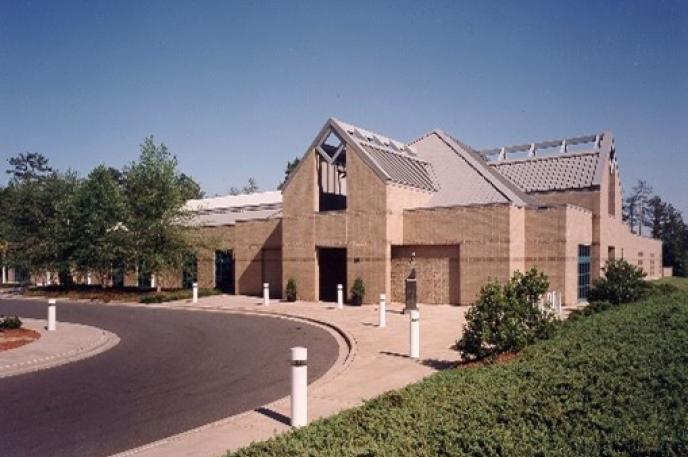
Get to know the University City Regional Library community
January 24, 2022
The University City Branch is located at 301 E. W.T. Harris Blvd next to the Atrium Health University City hospital and its medical offices. The 24,500 square-foot library has several spaces for you to work, use our computers, browse books, DVDs, and magazines while being a part of the vibrant University City community.
It is hard to feel down in our branch while you are surrounded by natural light and cheerful staff. The branch has colorful walls ranging from a trendy periwinkle to a lively chartreuse. Grab a book and lounge at a table to view the greenspace out one of our floor to ceiling windows. You may even spot a family of deer!
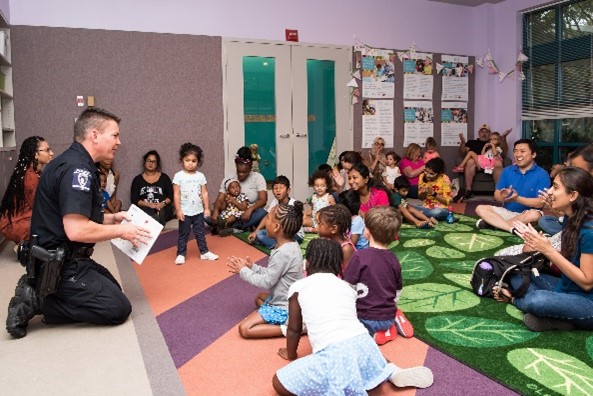 Swing by the Children’s Area to dance on the cool underwater area rug or read a book in our treehouse. University City has a lot of children’s materials including more than fourteen shelves of graphic novels, educational computers, board books for babies and rentable tablets preloaded with educational apps. Teens can hang out and relax in the Teen Zone while adults browse the large print collection or magazines. University City Regional Library has a diverse collection of books in international languages including Spanish, Arabic, Russian, Chinese, Gujarati, French, Korean and other languages. We really have something for everyone!
Swing by the Children’s Area to dance on the cool underwater area rug or read a book in our treehouse. University City has a lot of children’s materials including more than fourteen shelves of graphic novels, educational computers, board books for babies and rentable tablets preloaded with educational apps. Teens can hang out and relax in the Teen Zone while adults browse the large print collection or magazines. University City Regional Library has a diverse collection of books in international languages including Spanish, Arabic, Russian, Chinese, Gujarati, French, Korean and other languages. We really have something for everyone!
The University City Library even houses a small art collection including community created pieces. Visit the branch to see a special art piece by NC artist, Jon Kuhn. The glass piece “Cubic Harmony” is a unique glass cube in the front of the building by the Circulation Desk. Make sure to visit during daylight to watch the cube sparkle and glimmer from the reflection of the sunlight through our sky lights.
University City Library staff love interacting with our community by taking part in several local festivals including Charlotte Kids Fest. Kids Fest is an annual celebration for the kids of Charlotte with fun and educational activity zones for children of all ages including a create and dance zone. The University City area also hosts the annual Wine Fest. Cresent Communities Wine Fest is a unique cultural event for the area featuring pop-up shops, fun dining experiences, live entertainment, and wine from several regional wineries.
 After visiting University City Library, check out the boardwalk area to shop, dine and even ride a paddle boat. The Shoppes at University City Place is a staff favorite place to unwind and read during a lunch break. The boardwalk has benches overlooking the water where you can relax and interact with geese. The walking trail around the water is a wonderful place for a nice stroll while listening to one of the library’s new audiobooks. Visit the University City Partners for exciting new details about the development in the area.
After visiting University City Library, check out the boardwalk area to shop, dine and even ride a paddle boat. The Shoppes at University City Place is a staff favorite place to unwind and read during a lunch break. The boardwalk has benches overlooking the water where you can relax and interact with geese. The walking trail around the water is a wonderful place for a nice stroll while listening to one of the library’s new audiobooks. Visit the University City Partners for exciting new details about the development in the area.
The University City area is home to the University of North Carolina at Charlotte and more than 20 regional offices for Fortune 500 companies. You can access the library by riding the LYNX Blue Line Light Rail extension and walking a short distance. If you have out of town guests, check them into one of the neighboring hotels around the area. There is plenty to do in University City as it is located close to several highways.
New to Charlotte? Explore other neighborhoods through the Charlotte Mecklenburg Library blog and WelcomeCLT, a digital space created for newcomers to Charlotte.
Resources:
- University City Regional Branch – 301 E. W.T. Harris Blvd, Charlotte, NC 28262 | 704-416-7200
- University City Wine Festival – 8929 J M Keynes Dr Ste 315, Charlotte, NC 28262 | 704-549-4811
- Shoppes at University City Place – 8929 J M Keynes Dr, Charlotte, NC 28262 | 704-549-4811
- University City Partners – 8801 J M Keynes Dr #450, Charlotte, NC 28262 | 704-688-2483
- LYNX Blue Line Light Rail – Operates from I-485 at South Boulevard to UNC Charlotte’s main campus in University City
--
This blog written by Leanda Gahegan, children’s librarian for Charlotte Mecklenburg Library, with photographs provided by Everett Blackmon, access services manager for Charlotte Mecklenburg Library.

Ahmaud Arbery trial reveals historical pitfalls with justice and race
January 25, 2022
This blog was written as part of Charlotte Mecklenburg Library's Black Lives Matter program initiative. Learn more about the program and corresponding events here.
“A jury of 11 whites and one Black, in the deep South, stood up in the courtroom and said that Black lives do matter,” said Reverend Al Sharpton last November following the conviction of three defendants in the murder trial of Ahmaud Arbery, according to Newsweek magazine. Sharpton, the civil rights activist and Baptist minister, said this as he, and the national media among others, gathered in southeast Georgia for the announcement of the verdict.
The nature of Arbery’s death echoed America’s violent, racist past of lynching. While jogging, Arbery was suspected of break-ins by two white men who grabbed their firearms, pursued, and confronted him with his death being the result. The Washington Post columnist Eugene Robinson wrote, “The killing of Ahmaud Arbery, a young Black man who had the gall to jog through a mostly White neighborhood, was nothing but a classic lynching of the kind that could have happened a century ago.”
A recount of events is in order to explain this national news story. After all, Arbery’s name was chanted with George Floyd and others during the protests for racial justice that spread around parts of the world during the summer of 2020. Arbery was killed on February 23, 2020.
The New York Times provides a timeline of the case here including Gregory and Travis McMichael’s altercation with Arbery, the changing of prosecutors which finally led to criminal charges, and the release of a video of the incident. A neighbor of the McMichael’s, William Bryan, was later added and charged in Arbery’s death.
The newspaper timeline also details family and community support to identify Arbery as a crime victim. The state’s criminal justice process was evaluated during the process as one prosecutor faces criminal charges. That occurred because of her actions leading her to recuse herself from the case. The case’s attention also led to lawmakers weakening the state’s citizen’s arrest law.
In February, the McMichaels and Bryan will face federal charges of committing hate crimes in this case. Why those charges are necessary is spelled out by Robinson as he writes “the Arbery case was potentially more explosive because it was so specifically about race — and because it had such specific historical resonance.” To read books about trials in America’s past of a similar nature, explore the booklist titled "Notable Trials of African Americans".
Notable Trials of African Americans booklist
--
This blog was written by Lawrence Turner, adult services librarian at South County Regional Library.
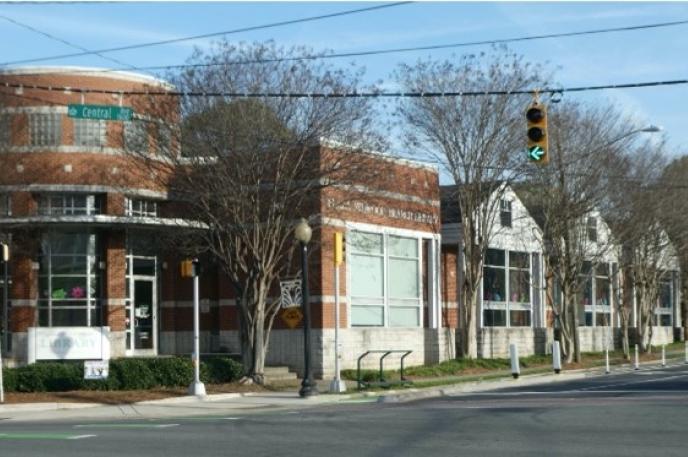
Get to know the Plaza Midwood Branch Library
January 25, 2022
The Plaza Midwood Branch Library is located on the East side of Charlotte, just minutes from Uptown, and serves as a connector for both residents and businesses within its community. Those immigrating to the neighborhood will find beautiful parks, cultural centers, and delicious international cuisine nearby. Located in the heart of Plaza Midwood, the library offers computers with internet access and lots of natural light with adjacent seating where customers can enjoy reading one of its many books or magazines.
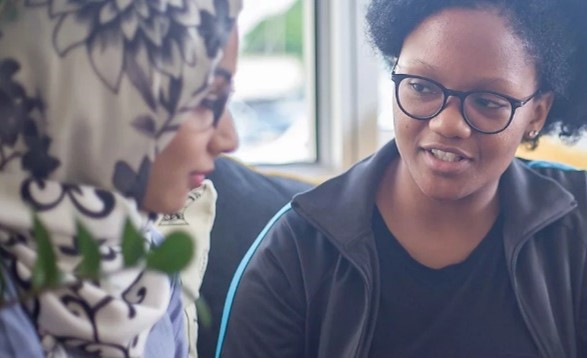 International House is a huge asset to Plaza Midwood’s international community. It offers programs that support immigrants seeking pathways to citizenship, cultural programs (like book clubs and Young Professionals), a Citizen Diplomacy Program, and English language acquisition programs. If English is a second language for you, you may be interested in the Plaza Midwood library’s vast collection of world language materials, primarily in Spanish, but in ten other languages as well, such as Chinese, French, Russian, and Korean.
International House is a huge asset to Plaza Midwood’s international community. It offers programs that support immigrants seeking pathways to citizenship, cultural programs (like book clubs and Young Professionals), a Citizen Diplomacy Program, and English language acquisition programs. If English is a second language for you, you may be interested in the Plaza Midwood library’s vast collection of world language materials, primarily in Spanish, but in ten other languages as well, such as Chinese, French, Russian, and Korean.
After visiting the library, why not grab a bite at one of the many unique restaurants nearby? Plaza Midwood encompasses Mexican, Ethiopian, Chinese, Vietnamese, and Bosnian cuisines within its borders. Or spend some time outdoors at one of its neighborhood parks. Veterans Park covers 19 acres off Central Avenue; it features baseball fields, tennis courts, a basketball court, playground, trails, and a sprayground for kids. Midwood Park also features sports facilities and a playground, but it also offers an amphitheater and a community garden on its six acres; it is also the spot for many of the neighborhood’s annual festivals.
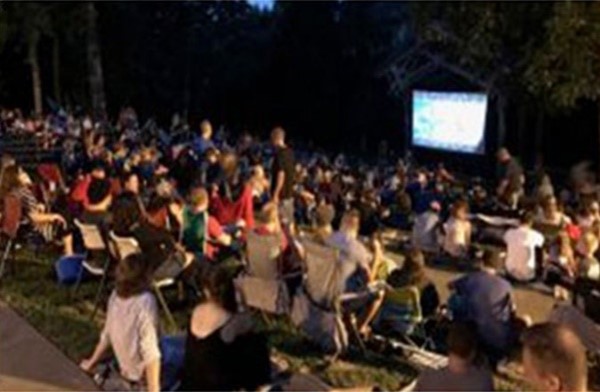 Neighborhood festivals are another great way to interact with the community. The Plaza Midwood Neighborhood Association kicks off its festivities each year in May with Midwood Maynia at Midwood Park where there will be live music, food, beer from a local brewery, a parade, great local merchants and fun activities for the kids. While the weather’s still warm, the neighborhood holds Movies in Midwood Park where residents can watch movies under the stars and enjoy free popcorn. On the last Saturday in October, the PMNA holds its annual Fall Crawl. The day begins with a costume parade and Trunk or Treat for kids, followed by a full day of beer, food trucks, live music, local merchants, and tons of activities for the kids in Midwood Park. Check out PMNA’s events calendar for more activities throughout the year.
Neighborhood festivals are another great way to interact with the community. The Plaza Midwood Neighborhood Association kicks off its festivities each year in May with Midwood Maynia at Midwood Park where there will be live music, food, beer from a local brewery, a parade, great local merchants and fun activities for the kids. While the weather’s still warm, the neighborhood holds Movies in Midwood Park where residents can watch movies under the stars and enjoy free popcorn. On the last Saturday in October, the PMNA holds its annual Fall Crawl. The day begins with a costume parade and Trunk or Treat for kids, followed by a full day of beer, food trucks, live music, local merchants, and tons of activities for the kids in Midwood Park. Check out PMNA’s events calendar for more activities throughout the year.
New to Charlotte? Explore other neighborhoods through the Charlotte Mecklenburg Library blog and WelcomeCLT, a digital space created for newcomers to Charlotte.
Resources:
- Plaza Midwood Branch Library - 1623 Central Ave, Charlotte, NC 28215 | 704-416-6200
- International House - 1817 Central Ave., Suite 215, Charlotte, NC 28215 | 704-333-8099
- Mecklenburg County Parks & Rec - 2435 Cumberland Avenue, Charlotte, NC 28215 | 980-314-1002
- Plaza Midwood Neighborhood Association - PO Box 9394, Charlotte, NC 28215
--
This blog was written by Lauren Mullins, adult services librarian at Charlotte Mecklenburg Library.
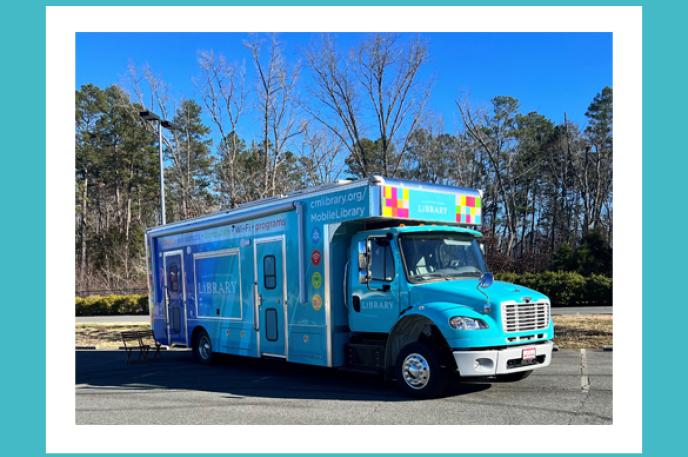
Join Us January 29, 2022 to Meet MoLi! Charlotte Mecklenburg Library’s new Mobile Library
January 25, 2022
Come meet MoLi, Charlotte Mecklenburg Library’s new Mobile Library on Saturday, January 29 at the Eastway Regional Recreational Center (3150 Eastway Park Drive, 28213) from 10 a.m.-12 p.m. There will be giveaways, tours, live storytimes, a puppet show and more! Click here to read more about MoLi.

